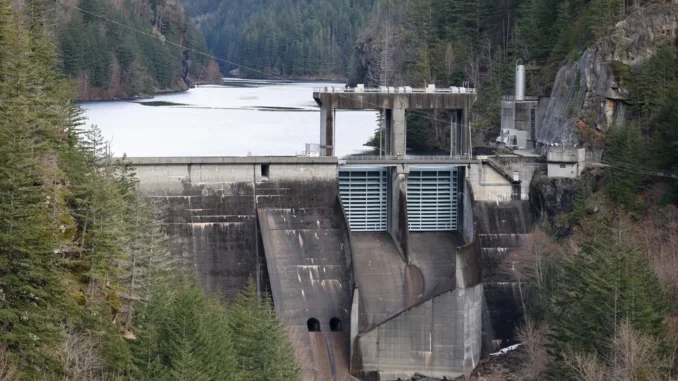
Think you have been paying more for electricity? You’re right. Across the Seattle area, power bills have been taking a toll on budgets as providers, squeezed by inflation and green-energy requirements, raised rates.
Electricity rates in the Seattle metropolitan area increased 6.7% between April 2022 and April 2023, according to data from the U.S. Bureau of Labor Statistics. In April rates were 11.4% higher than five years ago, and 33.7% higher compared with 10 years ago.
Despite the increases, electricity prices in the Seattle metropolitan area remained 23% below the national average, according to BLS data.
While each of the Seattle-area power providers — Puget Sound Energy, Seattle City Light, the Snohomish Public Utility District and Tacoma Power — has a different set of reasons for increasing rates, the cost of infrastructure coupled with inflation is one common cause.
Infrastructure is the biggest source of cost for utility providers, said the University of Washington’s professor of energy and power systems Daniel Kirschen. For example, he said, it’s costly to maintain dams and transmission lines.
Understanding the hikes
To get the rate increases approved, utility providers have to make their case to city councils and the Utilities and Transportation Commission that the cost of providing electricity to customers has increased and explain the factors that led to this increase, Kirschen said.
And so far, Kirschen said, the overall increase in rates shown in the BLS data suggests the providers have been successfully making their case.
In October, the state’s largest utility provider, Bellevue-based PSE, announced it filed proposals for rate increases, citing a number of reasons, including “rising natural gas prices, state policy objectives for clean energy and continued investments in system reliability and safety.”
But the biggest driver of PSE rate increases has been the infrastructure needed to comply with Washington’s Clean Energy Transformation Act, according to the company. Signed into law by Gov. Jay Inslee in 2019, the act commits the state to an electricity supply with no greenhouse gas emissions by 2045.
In its argument to the UTC for a rate increase, PSE said its costs increased also in part because of the Climate Commitment Act, which “caps and reduces greenhouse gas emissions from Washington’s largest emitting sources and industries.” The program works alongside other climate policies to help the state reach its commitment to reduce greenhouse gas emissions by 95% by 2050, according to the state.
PSE supplies electricity service to more than 1.1 million customers in eight Washington counties, including parts of King County.
The typical residential electric customer’s bill increased about $8.73 per month this year and will increase an additional $1.48 next year.
Last fall, Seattle’s City Council approved a 4.5% rate increase for 2023 and 2024 as part of City Light’s six-year strategic plan, which is reviewed every two years.
Seattle City Light, as a public utility, does not have to seek the approval of an external commission like the Washington Utilities and Transportation Commission. Rather, rates are passed in the City Council.
City Light’s 5.7% increase for residential customers, which took effect Jan. 1, was a result of inflation, labor and infrastructure costs, said Carsten Croff, City Light’s financial and rates planning manager, in an interview in May. One example of increased costs for City Light is transformers, he said.
Transformers are “made up of a lot of different metals and materials,” Croff said. “We are continuously replacing transformers throughout our service territory and are also installing new transformers for new customers.”
Similar to City Light, Tacoma Power experienced “increased costs for equipment, fuel, personnel and other expenses,” according to a Tacoma Power fact sheet. In addition to inflation, increased costs were a result of supply-chain shortages, postponed projects and COVID-19 impacts.
“Our increased costs are significant enough that our rates must also be increased to cover them,” the fact sheet stated. “By gradually increasing rates over time, we can prevent large increases.”
Residential customers in Tacoma have already felt the 3.9% average increase in electricity rates, approved for 2023 and 2024, that went into effect April 1.
The Snohomish Public Utility District said in a statement its rate increase, which took effect April 1, was because of higher material costs and inflationary pressure, while also ensuring it can fund investments in infrastructure and grid and service modernization. But it added that even though customers are paying more, the Snohomish PUD’s rates are still below the average in the Seattle area.
In Snohomish County, rates increased 2%, or an average total increase of about $4 a month.
Future investments
The ongoing push for green energy and higher demand might lead to a continued increase in rates.
In June, PSE announced the UTC approved the provider’s green energy plan. When the Centralia coal-fired power plant retires at the end of 2025, PSE is set to meet the goal of 63% renewable energy, according to the company.
To meet the fully renewable grid goal, PSE has to deliver 15,000 megawatts of clean energy by 2045, which translates to improvements such as 700,000 residential solar panel systems, 50,000 residential battery storage systems, 1,250 wind turbines and 45 solar plants.
PSE’s supply portfolio consists of 27% natural gas, 24% hydroelectric and 23% coal. Wind makes up 11% and unspecified sources, which could be electricity traded in open market transactions, make up 14%, according to the utility provider.
When PSE filed for a rate increase in January, it sought the recovery of $166.5 million in power costs, including $135.8 million related to its modeling of Climate Commitment Act impacts. The commission approved only a $30.7 million adjustment to power costs, and said PSE may choose to submit another request for the recovery of the remainder of $135.8 million in the filing period for 2024 forecast power costs. If approved, PSE consumers are likely to see another increase in the future.
Unlike PSE, City Light’s energy portfolio is largely made up of renewables. Hydro and wind make up 91% of the portfolio, followed by 5% nuclear energy, 3% unspecified and 1% biogas.
For the 2023 and 2024 rates, Croff said, the impact on costs from the state’s Clean Energy Transformation Act was minimal. But City Light anticipates there will be “some cost pressures.”
“Those renewables have grown quite a bit in price,” Croff said. “We’ll be seeing the cost pressures from those new renewable energies, but some of that is already built into our strategic plan.”
Tacoma Power will begin its biennium budget planning in the spring of 2024 and will know next year whether there will be proposed rate increases. If the provider does propose increases, it will go to the Public Utility Board and Tacoma’s City Council in the fall of next year, said communications manager Rebekah Anderson.
The UW’s Kirschen said he expects rates to go up as the increasing demand for electricity — to power electric vehicles, for example — leads to a need for bigger infrastructure.
“To support this electrification, we will need even more renewable sources of energy. To connect these sources to the consumers, we will need to build more transmission and distribution capacity,” Kirschen said. “Rates will need to increase to pay for these investments.”


